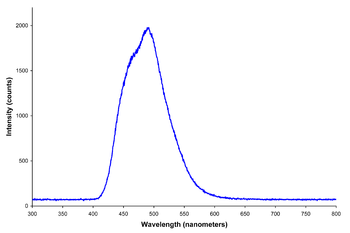Electroluminescence
From Wikipedia, the free encyclopedia

Electroluminescence (EL) is an optical phenomenon and electrical phenomenon in which a material emits light in response to an electric current passed through it, or to a strong electric field. This is distinct from light emission resulting from heat (incandescence), chemical reaction (chemiluminescence), sound (sonoluminescence), or other mechanical action (mechanoluminescence).
Contents |
[edit] Mechanism
Electroluminescence is the result of radiative recombination of electrons and holes in a material (usually a semiconductor). The excited electrons release their energy as photons - light. Prior to recombination, electrons and holes are separated either as a result of doping of the material to form a p-n junction (in semiconductor electroluminescent devices such as LEDs), or through excitation by impact of high-energy electrons accelerated by a strong electric field (as with the phosphors in electroluminescent displays).
[edit] Examples of electroluminescent materials
The dopant typically defines the visible color emitted, while the semiconductor needs to have wide enough bandwidth to allow exit of the light. The most typical Thin Film EL (TFEL), for example, is ZnS:Mn with its yellow-orange emission. Examples of the range of EL material include:
- Powder zinc sulfide doped with Copper or Silver
- Thin film zinc sulfide doped with Manganese
- Natural blue diamond (diamond with boron as a dopant).
- III-V semiconductors - such as InP,GaAs,and GaN.
- Inorganic semiconductors - such as [Ru(bpy)3]2+(PF6-)2, where bpy is 2,2'-bipyridine
[edit] Practical implementations

The most common EL devices are either powder (primarily used in lighting applications) or thin film (for information displays.)
Electroluminescent automotive instrument panel backlighting, with each gauge pointer also an individual light source, entered production on 1960 Chrysler and Imperial passenger cars, and was continued successfully on several Chrysler vehicles through 1967.
Sylvania produced and marketed an EL night lamp (right), under the trade name "Panelescent" at roughly the same time that the Chrysler IP's entered production. These lamps have proven incredibly reliable, with some samples known to be still functional after nearly 50 years of continuous operation.
Powder phosphor-based electroluminescent panels are frequently used as backlights to liquid crystal displays. They readily provide a gentle, even illumination to the entire display while consuming relatively little electric power. This makes them convenient for battery-operated devices such as pagers, wristwatches, and computer-controlled thermostats and their gentle green-cyan glow is a common sight in the technological world. They do, however, require relatively high voltage. For battery-operated devices, this voltage must be generated by a converter circuit within the device; this converter often makes an audible whine or siren sound while the backlight is activated. For line-voltage operated devices, it may be supplied directly from the power line. Electroluminescent nightlights operate in this fashion.
Thin film phosphor electroluminescence was first commercialized during the 1980s by Sharp Corporation in Japan, Finlux (Oy Lohja Ab) in Finland, and Planar Systems in the USA. Here, bright, long life light emission is achieved in thin film yellow-emitting manganese-doped zinc sulfide material. Displays using this technology were manufactured for medical and vehicle applications where ruggedness and wide viewing angles were crucial, and liquid crystal displays were not well developed.
Recently, blue, red, and green emitting thin film electroluminescent materials have been developed that offer the potential for long life and full color electroluminescent displays.
In either case, the EL material must be enclosed between two electrodes and at least one electrode must be transparent to allow the escape of the produced light. Glass coated with indium oxide or tin oxide is commonly used as the front (transparent) electrode while the back electrode is or is coated with reflective metal. Additionally, other transparent conducting materials, such as carbon nanotube coatings or PEDOT can be used as the front electrode.
The display applications are primarily "passive" (i.e. voltages are driven from edge of the display.) Similar to LCD trends, there have also been Active Matrix EL (AMEL) displays demonstrated, where circuitry is added to prolong voltages at each pixel. The solid state nature of TFEL allows for a very rugged and high resolution display facbricated even on silicon substrates. AMEL displays of 1280x1024 at over 1000 lines per inch (lpi) have been demonstrated by a consortium including Planar Systems. {A couple of references for AMEL include Ron Khormaei, et.al., " High Resolution Active Matrix Electroluminescent Display," Society for Information Display Digest, p. 137, 1994. And at Planar's http://www.planar.com/advantages/whitepapers/docs/overview.pdf)
Electroluminescent technologies have low power consumption compared to competing lighting technologies, such as neon or fluorescent lamps. This, together with the thinness of the material, has made EL technology valuable to the advertising industry. Relevant advertising applications include electroluminescent billboards and signs. EL manufacturers are able to control precisely which areas of an electroluminescent sheet illuminate, and when. This has given advertisers the ability to create more dynamic advertising which is still compatible with traditional advertising spaces.
In principle, EL lamps can be made in any color. However, the commonly-used greenish color closely matches the peak sensitivity of human vision, producing the greatest apparent light output for the least electrical power input. Unlike neon and fluorescent lamps, EL lamps are not negative resistance devices so no extra circuitry is needed to regulate the amount of current flowing through them.

[edit] See also
[edit] External links
- Overview of electroluminescent display technology, and the discovery of electroluminescence
- Chrysler Corporation press release introducing Panelescent (EL) Lighting on 8 September, 1959.
- First large format EL advertising campaign in Vienna made by elontech.eu.
- Electroluminsecent Commercial Application



